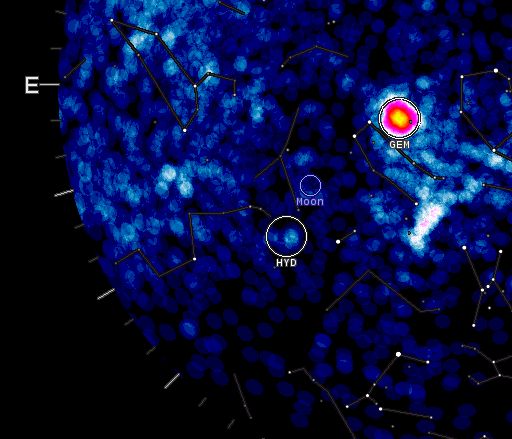Learn to photograph Northern Lights like a pro. Sign up for Peter Rosen's Aurora Photo Courses in Abisko National Park. | | |
QUIET WITH A CHANCE OF FLARES: Solar activity has been low for days. The sunspot most likely to break the quiet is AR2230. Not only is the sunspot growing rapidly, but also it has an unstable 'beta-gamma' magnetic field that harbors energy for M-class solar flares. NOAA forecasters estimate a 20% chance of such an explosion on Dec. 10th.Solar flare alerts: text, voice
LAUNCH OF THE NEUTRON DETECTOR: For more than a year, the students of Earth to Sky Calculus have been launching Space Weather Buoys to the stratosphere to monitor cosmic radiation. Yesterday, they launched a Space Weather Buoy, version 2.0. In addition to the X-ray/gamma-ray sensors normally flown, the payload also carried a neutron detector:

Neutrons are important because they provide much of the biologically effective radiation dose at altitudes of interest to aviation and space tourism. Low-energy neutrons also cause single-event upsets in aircraft avionics, especially devices that contain Boron 10. Adding a neutron sensor to the Buoy allows the students to monitor this important form of radiation at altitudes ranging from ground level to 120,000 feet.
This was just a test flight to evaluate one possible neutron counter. GPS data indicate that the payload successfully reached the stratosphere and parachuted back to Earth, landing in a remote corner of Death Valley National Park. Soon, a recovery team will collect the payload and the data it contains. Did the detector survive the trip? Did the Buoy detect neutrons in the stratosphere? Stay tuned for answers--and pretty pictures--in the days ahead.
Hey thanks! The students wish to thank the generous folks at MagoGuide.net for sponsoring the flight. MagoGuide is a fantastic travel web site, providing global access to local knowledge to adventurers around the world. Their donation of $500 got this mission off the ground!
Realtime Space Weather Photo Gallery
GEMINID HOT SPOT: Earth is moving deeper into the debris stream of rock comet 3200 Phaethon, source of the annual Geminid meteor shower. From the countryside near Tavistock, Ontario, the Canadian Meteor Orbit Radar (CMOR) is monitoring a "hot spot" in the sky where Geminid meteoroids are hitting Earth's atmosphere at 78,000 mph. This radar map was produced on Dec. 10th:

That hot spot is called the shower's radiant. It is the point in the sky from which disintegrating meteoroids emerge. The Geminids get their name from the location of the radiant--that is, the constellation Gemini.
Note the position of the Moon. It is passing by Gemini today. As a result, lunar glare is hiding many meteors from human eyes. The Canadian radar, on the other hand, is unaffected by moonlight, so it is able to detect Geminid activity despite the glare.
Visibility will improve in the nights ahead as the Moon wanes and Earth moves deeper into the Geminid debris stream. Forecasters expect the shower to peak on Dec. 13-14 with as many as 120 meteors per hour. Wherever you live, the best time to look is during the hours between midnight and dawn on Saturday and Sunday.
Got clouds? No problem. You can still experience the Geminids by listening for their echoes in this live audio stream from Spaceweather.com's forward scatter meteor radar.
Realtime Meteor Photo Gallery
Realtime Aurora Photo Gallery
Realtime Comet Photo Gallery
Every night, a network of NASA all-sky cameras scans the skies above the United States for meteoritic fireballs. Automated software maintained by NASA's Meteoroid Environment Office calculates their orbits, velocity, penetration depth in Earth's atmosphere and many other characteristics. Daily results are presented here on Spaceweather.com.
On Dec. 10, 2014, the network reported 33 fireballs.
(20 sporadics, 6 Geminids, 5 sigma Hydrids, 2 December Monocerotids)

In this diagram of the inner solar system, all of the fireball orbits intersect at a single point--Earth. The orbits are color-coded by velocity, from slow (red) to fast (blue). [Larger image] [movies]
Potentially Hazardous Asteroids (
PHAs) are space rocks larger than approximately 100m that can come closer to Earth than 0.05 AU. None of the known PHAs is on a collision course with our planet, although astronomers are finding
new ones all the time.
On December 10, 2014 there were potentially hazardous asteroids.
Notes: LD means "Lunar Distance." 1 LD = 384,401 km, the distance between Earth and the Moon. 1 LD also equals 0.00256 AU. MAG is the visual magnitude of the asteroid on the date of closest approach. | | The official U.S. government space weather bureau |
| | The first place to look for information about sundogs, pillars, rainbows and related phenomena. |
| | Researchers call it a "Hubble for the sun." SDO is the most advanced solar observatory ever. |
| | 3D views of the sun from NASA's Solar and Terrestrial Relations Observatory |
| | Realtime and archival images of the Sun from SOHO. |
| | from the NOAA Space Environment Center |
| | the underlying science of space weather |

